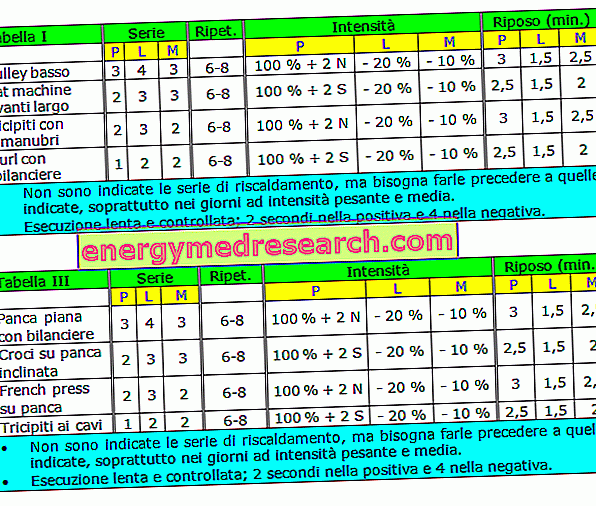Definition and Causes
Tearing or muscle distraction is a rather serious injury that causes the breakdown of some fibers that make up the muscle. This injury is generally caused by excessive stress (sharp contractions or sudden jerks) and is quite common in sports (especially in sports that require explosive muscle movement such as weight lifting, baseball, soccer, sprinting and jumping competitions).
Muscular tears often occur in conditions of poor training or when the muscle is particularly tired or unprepared to support stress (failure to warm up).

Classification
In relation to the number of fibers involved (in a muscle there are several thousand fibers) muscle tears can be classified using a gravity scale composed of three stages.
FIRST GRADE LESION
Only a few muscle fibers are damaged in this type of injury (less than 5%). All in all the damage is modest and is perceived as a slight discomfort that is accentuated during muscle contraction and stretching. Therefore, in the case of first degree injury there is no significant loss of strength or limitation of movement.
SECOND DEGREE INJURY or serious injury
The severity of the tear increases as more fibers are involved. The acute pain is similar to a sharp pain and is clearly felt following a violent muscular contraction. The injury interferes with the athletic gesture but allows the athlete to continue the race or training. However the pain can be aggravated by any attempt to contract the muscle.
THIRD GRADE LESION or very serious injury
The high number of fibers involved causes a real laceration of the muscle belly (complete or semi-complete, however, involving at least 3/4 of the fibers). This lesion is felt on palpation as a depression, a veritable step that testifies to the extent of the rupture.
The very violent pain causes a complete functional impotence so that if the lesion involves the lower limbs the athlete immediately falls to the ground

Muscle tearing can be compared to the progressive breaking of a rope put in tension by two tie rods. At first only a few fibers are untangled (first degree lesion) and as the traction force is increased the fraying becomes more and more evident (degree II injury) until the rope is completely broken (3rd degree lesion) .
Symptoms
To learn more: Muscular Tear Symptoms
The subject affected by a muscle tear feels a sharp pain in the injured area, the more intense the greater the number of fibers involved. The pain felt is often evoked by the contraction of the affected muscle. If the trauma is particularly serious the subject is unable to move the affected part and the muscle appears rigid and contracted. A distraction of II or III degree is accompanied, in most cases, by edema and swelling.
Skeletal muscle is sprayed with a dense network of capillaries that are damaged if they are torn. This rupture causes more or less evident blood extravasation depending on the extent and location of the lesion. If in milder traumas the blood remains inside the muscle, in more severe ones it migrates to the surface where it accumulates and forms hematomas.
After about 24 hours, a bruise located lower than the tear site can be seen as evidence of blood extravasation. Furthermore, a "defense" muscle contraction may arise due to which the body tries to immobilize the affected area to promote recovery and prevent the situation from getting worse.
What to do - Treatment
See also: Medications for the treatment of muscle strains
The first thing to do is to stop sports immediately and immobilize the affected area. If in the most serious cases this suspension is a must in the milder cases, the subject, given the tolerability of the pain, is naturally inclined to grit his teeth and continue. In this way, however, the risk of aggravating the situation considerably increases, so it is advisable to stop as soon as possible even if the pain felt is minor.
After stopping, avoid loading the limb and place it in a resting position (raised position).
Immediately apply a cold pack (ice bag, spray etc.) to the affected area to reduce blood flow to the damaged vessels (vasoconstriction). At the same time, avoid any form of heat (massages, ointments, mud, etc.).
Contact a specialized doctor and undergo instrumental tests to assess the true extent of the damage.
First degree lesions resolve within 1-2 weeks, in which the athlete is kept at rest and treated with anti-inflammatories and muscle relaxants. Some stretching exercises can help speed up and improve recovery by re-elasticating scar tissue as much as possible.
Second degree injuries, on the other hand, involve longer healing times (15-30 days). Before resuming sports activities, the subject must follow a rehabilitation course and undergo appropriate physiotherapy interventions.
In severe cases (3rd degree injuries) surgery may be required.
Among the most effective physical therapies we point out tecar therapy, a method that is still not very widespread, which would allow us to halve recovery times thanks to the transfer of endogenous electrical charges to the deeper muscle layers.
Prevention
The fibers damaged by the muscle tear have poor capacity for regeneration. Excluding the intervention, still not well clarified, of the satellite cells the repair process takes place exclusively with the formation of a less elastic scar tissue, less contractile and also less resistant than the muscular one.
Thus areas of different elasticity can be formed that significantly increase the risk of recurrent injury.
It is therefore of fundamental importance to try to avoid as much as possible the risk of injury.
The prevention of muscle strains is characterized by the observance of some fundamental points:
- always perform a general and specific warm-up of the muscles
- make sure you are in the right physical condition to withstand the effort
- carefully assess the practicability of the pitch
- choose suitable clothing, cover well in the winter months and, if necessary, use specific creams during the heating phase
- always perform stretching exercises to improve muscle elasticity and flexibility both in the preparatory and anti-fatigue phases
Finally, we suggest not to underestimate any painful symptoms, even if they are mild. The prevention of the most severe muscular tears is also carried out with a correct therapy of the mildest forms.
Read also: Muscle Tear Remedies »



